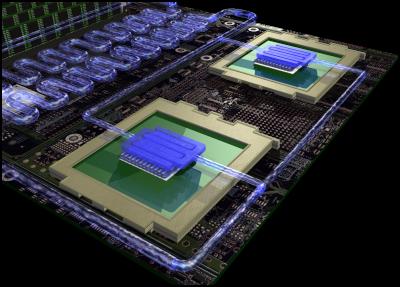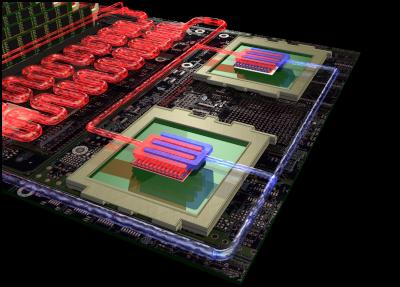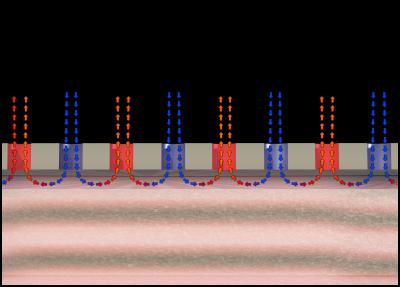NIWA buys IBM supercomputer
MEDIA RELEASE
31 August 2009
Under Strict Embargo Until 12.01am NZ Standard Time on Monday 31 August 2009
NIWA selects IBM to provide new Supercomputer to
advance environmental forecasting

Click for big version
Auckland, New Zealand, 31 August 2009 – The National Institute of Water & Atmospheric Research (NIWA) and IBM (NYSE:IBM) today announced a multi-million dollar partnership where NIWA will purchase one of the world’s most powerful supercomputers for use in environmental forecasting.
NIWA Chief Executive John Morgan says that the new IBM Power 575 supercomputer and its supporting infrastructure will cost $12.7 million and is one of the most significant single investments in science in New Zealand. NIWA’s new supercomputer will be the most powerful climate research supercomputer in the Southern Hemisphere.
“We have no doubt it will provide benefits for all New Zealanders, as accurate environmental forecasting is essential for the future growth of New Zealand’s most important industries,” he says.
“Industries that are climate-sensitive - such as the energy sector, farming, horticulture and tourism - will benefit directly from NIWA’s ability to make more accurate and more specific forecasts. The new supercomputer will also allow NIWA to improve early warnings of the effects of severe events, such as flooding and storm surge.”
IBM New Zealand’s Managing Director Jennifer Moxon says the IBM Power 575 enables NIWA’s environmental forecasting models and will help New Zealanders make smarter decisions about how best to protect themselves and their families, properties and businesses from flooding and other hazards caused by severe weather-related events.
The new supercomputer has one hundred times the computational power of NIWA’s current supercomputer and five hundred times the storage.
It will be used to simulate our past, present and future climate. On the present supercomputer, only a few decades can be simulated, but the new computer will enable complex simulations that describe hundreds of years of New Zealand's climate. The new models can account for the effects that land, ocean and atmospheric interactions, and human activities, will have on our future climate.
“NIWA plans to undertake complex and innovative research using this highly scalable IBM supercomputer. New Zealand's future competitiveness and economic growth depends on this ability to innovate, and high performance computing drives more innovation than any other technology," says Ms Moxon.
Hazards forecasting models that take 80 minutes to complete on 40% of the previous supercomputer will now take 8 minutes on about 4% of the new system – allowing more complex and comprehensive forecasting models to be developed.
These capabilities will have a significant impact. For example, flooding remains New Zealand’s most costly year-on-year physical hazard. Claims from damage caused by weather events in July and August last year are estimated at $68 million, according to the Insurance Council, and the 2004 Central North Island floods alone resulted in insurance claims of more than $400 million.
Given the high costs associated with flood damage, the ability to improve flood forecast lead times is expected to deliver significant economic benefit to New Zealand, Mr Morgan says. “The United Kingdom Met Office estimated the benefit to cost ratio of their similar supercomputer was nine times that of the total cost of ownership, based solely on its capability to improve flood forecast lead times.�
The supercomputer will also provide more computational power for NIWA’s world-class environmental forecasting system EcoConnect. EcoConnect provides forecasts of climate and weather-related information that are used by regional councils, energy companies, port companies, and other customers to mitigate hazards to their activities.
A recent survey by Green500.org found that IBM supercomputers are the most energy efficient in the world. NIWA’s new system will be cooled by an innovative water system, which will reduce air-conditioning needs by 80 per cent, in turn reducing typical energy consumption by 40 percent. The system includes using sea water from Evans Bay, which will save the equivalent of 50 households of electricity.
The supercomputer will be available to scientists throughout New Zealand through the Kiwi Advanced Research and Education Network (KAREN).
The IBM Power 575 also supports NIWA’s crucial role in the recently-announced Natural Hazards Research Platform, where different research organisations work closely together to understand, model and forecast natural hazards.
The supercomputer is similar to those used at major global environmental forecasting and research centres, such as the European Centre for Medium-Range Weather Forecasts (ECMWF), the US National Oceanic and Atmospheric Administration (NOAA), the US National Center for Atmospheric Research (NCAR), and the UK Met Office, and will underpin research collaborations with such international centres.
Fact sheet for NIWA’s Power
575/POWER6 Supercomputer
• For solving complex, grand challenge science problems, NIWA’s p575 will be the most powerful climate modelling supercomputer in the southern hemisphere. The system has been designed to tackle some of the world's most difficult problems in fields such as energy, aerospace, weather and climate modelling.
• The new supercomputer will be capable of performing 34 million million calculations per second, increasing to 65 million million calculations per second after an upgrade in 2011.
• The new system will initially have 740 magnetic disks, providing 0.6 Petabytes of data storage for users. Over time this will grow to 1200 disks and 1.4 Petabytes of data. In terms of magnetic tape storage, the two Automatic Tape Libraries can hold 5 Petabytes of data, the equivalent of more than 1,000,000 DVDs. This means that Ῡf a DVD were written to the tape libraries at the rate of one every minute, it would take more than 2 years before their capacity was exhausted.
• The IBM p575 uses water-chilled copper plates located above each micro-processor to remove heat from the electronics. IBM scientists estimate that water is up to 4,000 times more effective in cooling computer systems than air.
• NIWA’s IBM Power 575 is about 100 times faster than the current Cray T3E1200 system, which means models that used to take 80 minutes to complete on 40% of the previous system will now take 8 minutes on around 4% of the new system.
• This means that NIWA will be able to run hazards forecasting models that better describe landscape and coasts, use more observational data, and make more accurate and more reliable forecasts of hazards - especially flooding and coastal inundation.
• The supercomputer will also provide more computational power for NIWA’s world class environmental forecasting system EcoConnect, which provides forecasts of weather-driven hazards for customers.
Technical Specifications of NIWA’s Power 575
HPCF – Phase 1 (2009)
1) Hardware:
a) IBM p575/p6 supercomputer with 56 Power 6, 32 way 4.7 GHz nodes for a total of 1792 processors, and 3.6 Terabytes of memory;
b) Capable of performing 34 million million (i.e. 34 Trillion) calculations per second – about 7000 laptops all working together simultaneously.
c) More than 0.6 Petabytes (i.e. 600,000 Gigabytes) of disk storage on 740 disks in an IBM DCS9900 storage array.
d) Two IBM TS3500 Automatic Tape Libraries, each with 6 LTO-5 drives and capable of storing 2.5 Petabytes of data. One tape library will be for Disaster Recovery, and will contain copies of all data on the primary tape library.
e) p520/p6: 8 servers for HPC Management, GPFS (General Parallel File System), and TSM (Tivoli Storage Manager) functions.
f) BladeCenter: 48 Xeon 2.53 GHz processors for post processing tasks.
2) Software:
a) AIX operating system on all p520 servers and p575 nodes
b) General Parallel File System (GPFS) – accessible from all HPCF processors – both Power 6 and Intell/Xeon.
c) Tivoli Storage Manager (TSM) to provide backup and transparent movement of data between storage media
d) Tivoli Workload Scheduler software – to manage and schedule work on the HPCF
e) XL Fortran, C and C++ compilers
3) Environmentals
a) Power: 370 KW to run the system
b) Another 120 KW to cool the system, using chilled water and air
c) Weight: 12.6 tonnes, including water;
HPCF – Phase 2 (2011/12)
1) Upgrade will include:
a. Additional 52 Power 6, 32 way 4.7 GHz nodes for a total of 3456 processors, and 6.9 Terabytes of memory;
b. Be capable of performing 65 million million (i.e. 65 Trillion) calculations per second
c. Additional 0.8 Petabytes of disk storage for a total 1.4 Petabytes (i.e. 1,400,000 Gigabytes)
2) Environmentals:
a. Power: 675 KW to run the system
b. Another 225 KW to cool the system
c. Weight: 18.8 tonnes including water
About NIWA, National Institute of Water & Atmospheric Research
NIWA is a Crown Research Institute, with a global reputation as experts in water and atmospheric research. Our mission is to conduct leading environmental science to enable the sustainable management of natural resources for New Zealand and the planet. www.niwa.co.nz
About IBM
For additional information please visit www.ibm.com/deepcomputing.
ENDS




 Master Plumbers Gasfitters and Drainlayers NZ: New Consumer NZ Test Reveals Danger Of Unregulated Online Plumbing Products
Master Plumbers Gasfitters and Drainlayers NZ: New Consumer NZ Test Reveals Danger Of Unregulated Online Plumbing Products Mindful Money: Winners At The Mindful Money Annual Ethical & Impact Investment Awards 2025
Mindful Money: Winners At The Mindful Money Annual Ethical & Impact Investment Awards 2025 MBIE: Gas Supply Reducing Faster And Sooner Than Previously Forecast
MBIE: Gas Supply Reducing Faster And Sooner Than Previously Forecast Natural Hazards Commission: International Markets Show Unprecedented Confidence In NZ’s Natural Hazards Insurance Scheme
Natural Hazards Commission: International Markets Show Unprecedented Confidence In NZ’s Natural Hazards Insurance Scheme  ASB Bank: ASB Business Survey - The Impact Of Trump's Tariffs, According To Kiwi Businesses
ASB Bank: ASB Business Survey - The Impact Of Trump's Tariffs, According To Kiwi Businesses University of Auckland: Will Robots Help Older People Stay Sharp?
University of Auckland: Will Robots Help Older People Stay Sharp?


